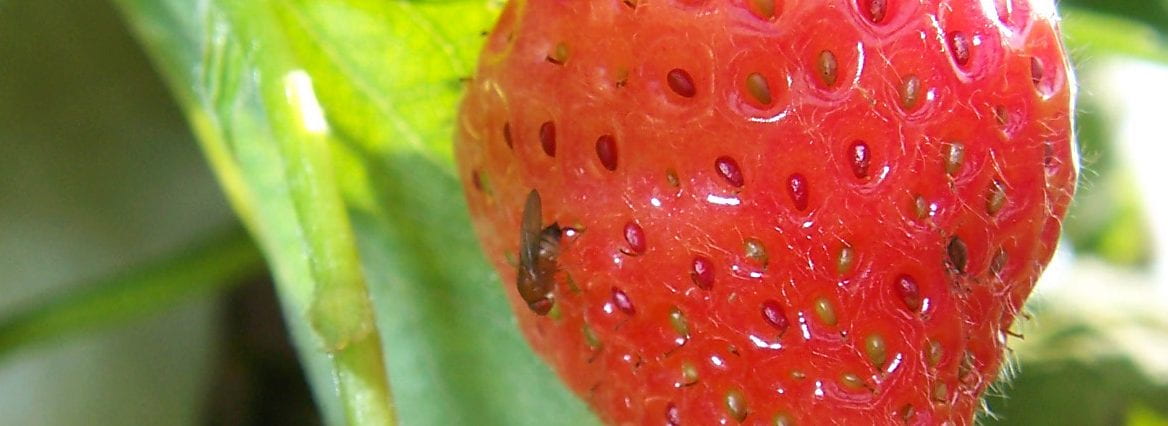Sustained catch, that is two weeks in a row, was obtained in two counties in Eastern NY, Ulster on June 19 and June 21 and Albany on June 22. Indeed, SWD catch was prevalent across New York State’s monitoring network in traps checked at the end of last week and early this week.
- Ulster site 5 had 1 male and 1 female in a blueberry field – fruit is ripening and will need to be protected. Checked June 19.
- Ulster site 6 had 4 males and 2 females in a raspberry planting – pink fruit will be picked clean and an insecticide applied to reset the field. Checked June 19.
- Ulster HVL had 5 males and 11 females in a cherry orchard – fruit is ripening and will need to be protected. Checked June 21.
- Albany had 10 males and 26 females in a raspberry field – ripening fruit will need to be protected. Checked June 22.

Are you seeing a pattern? With numbers this high, it will be imperative to begin a spray program to protect fruit. SWD populations have built up just as fruit are beginning to ripen. This translates into a challenging year for SWD management.
Those who choose not to spray will have to take every measure possible to prevent population build up. Exclusion netting should be the plan for these growers going forward, because without exclusion netting and without insecticide protection it’s impossible to bring sufficient fruit to harvest in years like 2020 when SWD populations build up early and crop development is delayed.
Learn more about exclusion netting, Thinking Exclusion? blogs.cornell.edu/swd1/2020/03/27/thinking-exclusion/
Renovate June strawberry fields promptly, blogs.cornell.edu/swd1/2018/06/27/renovate-strawberry-plantings-promptly/
Use salt flotation to routinely sample your fields. Read, Guidelines for Checking Fruit for SWD Larvae in the Field.
Pest management for SWD includes:
- Mowing – to reduce humidity and niches for SWD harborage and to increase sun penetration.
- Weed management – to reduce humidity, alternate fruiting hosts and harborage and to increase sun penetration.
- Pruning – to reduce humidity and to increase sun and spray penetration.
- Monitoring – to know if SWD is present when fruit is ripening.
- Sanitation – to reduce reproduction harborage and overall SWD population.
- Cold storage – to slow or kill any eggs and larvae in harvested fruit.
- Insecticide treatment – Insecticide Quick Guides for NY State:
- For berry crops www.hort.cornell.edu/fruit/pdfs/swd/berry-insecticides.pdf
- For stone fruit and grapes www.hort.cornell.edu/fruit/pdfs/swd/treefruit-grape-insecticides.pdf
Clean picking and treating with insecticide to “reset the field” is a management tactic used in large-scale commercial blackberry production in North Carolina. You may want to consider that tactic in your raspberry and blackberry plantings, if SWD has gotten ahead of you. It works best in such fruit crops that continue to flower and set fruit season-long.
SWD Management, fruit.cornell.edu/spottedwing/management/ on Cornell Fruit Resources.
SWD Management in Blueberry
Read this blog, Managing SWD in blueberries at https://blogs.cornell.edu/swd1/2019/08/02/managing-swd-in-blueberries/ .
Spotted Wing Drosophila IPM in Blueberries from the NE IPM Center SWD Working Group, http://neipmc.org/go/swdpub2
SWD Management in Raspberry and Blackberry
Read this blog, Managing SWD in raspberries and blackberries at https://blogs.cornell.edu/swd1/2019/07/17/managing-swd-in-raspberries-blackberries/
Spotted Wing Drosophila IPM in Raspberries and Blackberries from the NE IPM Center SWD Working Group, http://neipmc.org/go/swdpub1
Learn more about SWD.
Check out the information on Cornell Fruit Resources Spotted Wing Drosophila, http://fruit.cornell.edu/spottedwing/.
Thanks go out to Jim O’Connell, Ulster County CCE who is monitoring Ulster 5 and 6; Lydia Brown, Hudson Valley Research Laboratory, who is monitoring Ulster HVL (traps set in honeysuckle were at first catch this past week, too – one female); and Natasha Field, ENYCHP CCE, who is monitoring the Albany County site.

